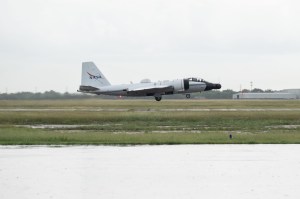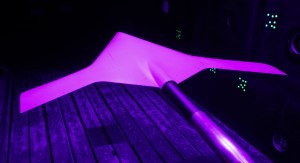NASA-developed computer software could help aircraft operators save time and fuel by allowing technology in the cockpit to help determine the most efficient flight paths while planes are in the air – in traffic – en route to their destinations.
A concept called Traffic Aware Strategic Aircrew Requests, or TASAR, is being developed at NASA’s Langley Research Center in Hampton, Va., as part of the NASA Airspace Systems Program. TASAR has been tested in labs and simulators and is now being assessed in flight. The software is loaded onto an “Electronic Flight Bag,” a tablet computer that many airlines and other pilots already use.
We want to provide better information to pilots about potential flight path savings, but in a way that is more affordable and approvable, and that supports how pilots and air traffic controllers work together today.

David Wing
NASA Langley Researcher
Wing and his team, including software developers from Engility Corporation in Billerica, Mass., will fly the software application on an Electronic Flight Bag integrated into a Piaggio P.180 Avanti aircraft, a high-performance aviation technology testbed owned and operated by Advanced Aerospace Solutions, LLC (AdvAero).
The TASAR software application accesses onboard aircraft systems for real-time flight data, including current position and the active route, to see if more efficient routes are available.
It doesn’t stop there. The software then connects with the plane’s ADS-B, or Automatic Dependent Surveillance-Broadcast, receiver and scans the broadcast signals of nearby traffic to make sure there are no potential conflicts in any proposed flight path changes – making it easier for air traffic controllers to okay a pilot’s route change request.
The TASAR system can go even further by using airborne Internet access for additional airspace information, such as real-time weather conditions and wind forecasts, to help make the flight even more efficient.
The NASA team has already checked out the concept during simulations at the University of Iowa Operator Performance Laboratory and gotten feedback from a dozen airline pilots who tested the technology. In addition, aerospace system manufacturer Rockwell Collins of Cedar Rapids, Iowa, has analyzed TASAR to make sure it is safe and can be readily certified by the Federal Aviation Administration.
One thing its developers say the new technology won’t need is changes in the roles and responsibilities of pilots or air traffic controllers. “The system is meant to be usable today, helping pilots make better, more efficient route requests in accordance with existing air traffic control and pilot procedures,” said Wing. “TASAR takes advantage of state-of-the-art computing, flight information specific to the aircraft and the emerging ADS-B infrastructure to help pilots make more informed requests that are more acceptable to air traffic controllers.”
Engility analysts have already studied how the software could benefit aircraft operators. They studied more than 500 standard airplane routes to identify how requests for different flight path changes could improve time and fuel efficiency. Then the researchers analyzed those same paths using TASAR capability. They found, on average, aircraft using the NASA-developed technology saved about one to four minutes of flight time and between 50 and 550 pounds of fuel per operation, depending on a number of different factors including the total length of the flight. As a result, several airlines have expressed interest in the TASAR technology and are furnishing pilots for the TASAR flight tests.


































